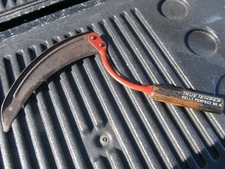Howdy all. Been reading all your sage advice for a while, but just registered to ask my own question after my search-fu failed... I'm making a "garden scythe" (aka a sickle or a kama), so I need to do a right angle from the blade down to the handle, but I only had long, straight, 1095 flat stock on hand. I'm getting close to finishing the shape and bevel, and now I am wondering if it would be stronger/better to heat and bend the thin bar 90°, or heat and shallowly wack a 45° groove in (cutoff tool or blunt chisel) and fold it over? (Yeah, that's how I roll: Ready! Fire! Aim!..?)
I'll try to figure out some images, I'm not sure I'm describing it well!
I'll try to figure out some images, I'm not sure I'm describing it well!
Last edited by a moderator:



 Thanks again, folks!
Thanks again, folks!